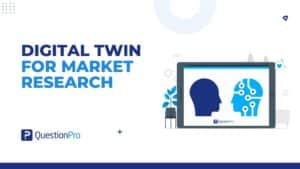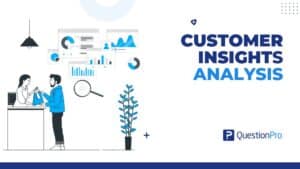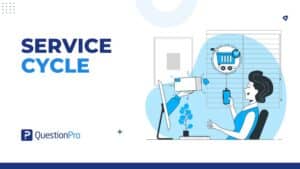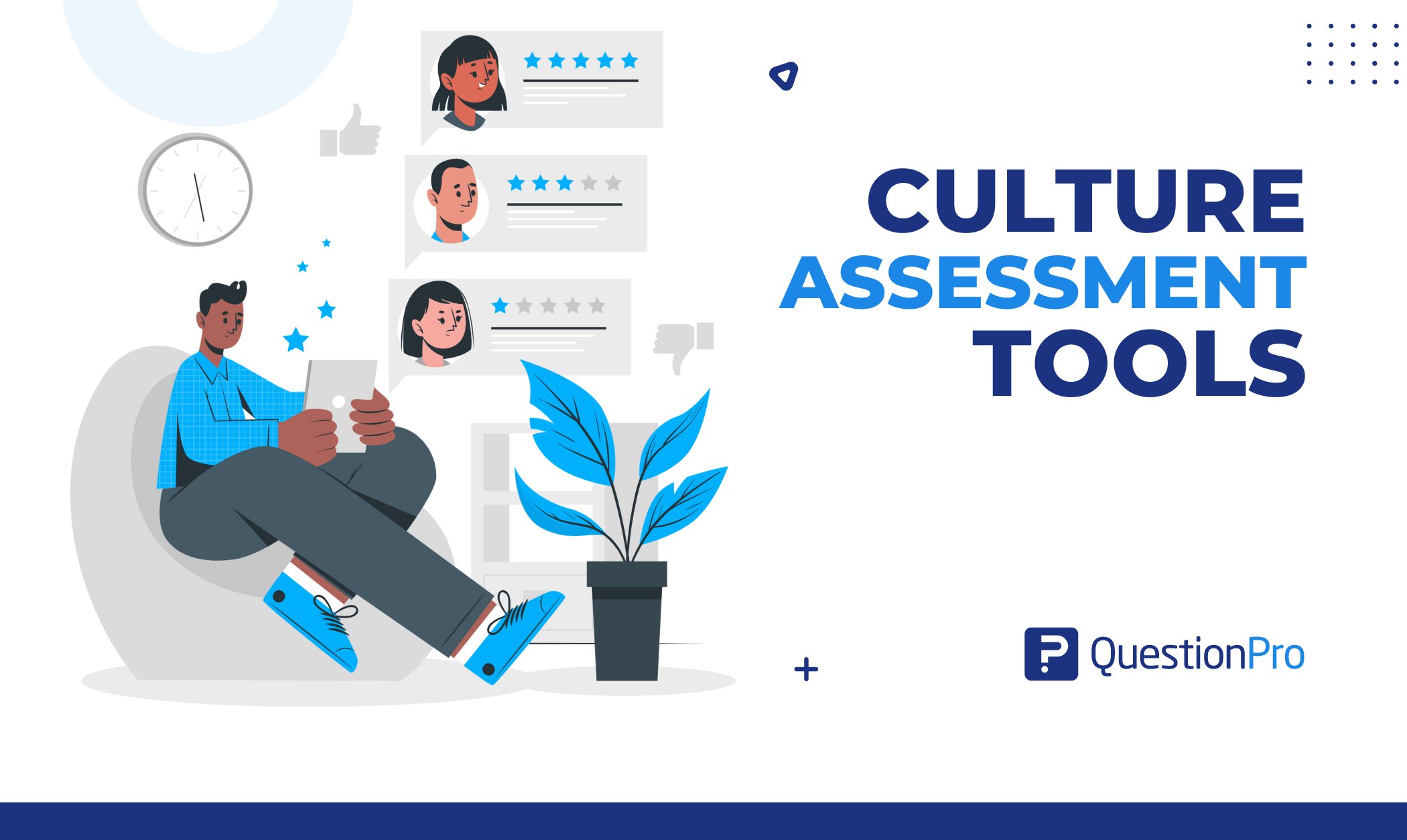
Culture assessment tools serve as the compass in this journey, providing insights into the depths of organizational culture and guiding strategic decisions. Navigating organizational culture can be akin to charting uncharted waters. Understanding the nuances of a company’s culture is crucial for leaders aiming to steer their ship toward success.
Measuring an organization’s culture can be challenging. While some parameters can be clearly defined, others can be difficult to spot. Culture assessment is a process that helps organizations differentiate between the ideal and real culture.
This includes an organization’s expectations, core values, philosophy, and employees’ behavior. However, when the objective is to change workplace culture, it is important to measure progress to ensure that your efforts are going in the right direction.
In this blog, we dive into the significance of culture assessment tools, their purpose, selection criteria, and how they can aid in transforming organizational culture.
What is a Culture Assessment Tool?
A Culture Assessment Tool is a structured method or instrument organizations use to evaluate and understand their organizational culture. It typically involves surveys, questionnaires, interviews, or observation techniques designed to gather data on the values, beliefs, behaviors, and practices that define the culture within a workplace.
The primary aim of such tools is to
- Diagnose the prevailing culture,
- Assess its alignment with organizational goals,
- Identify strengths and weaknesses,
- Uncover cultural barriers and
- Inform strategies for improvement and development.
These tools are valuable resources for leaders and managers to gain insights into their organization’s culture and make informed decisions to shape or transform it as needed.
What is the purpose of Culture Assessment tools?
The purpose of a Culture Assessment Tool is multifaceted and includes the following key objectives:
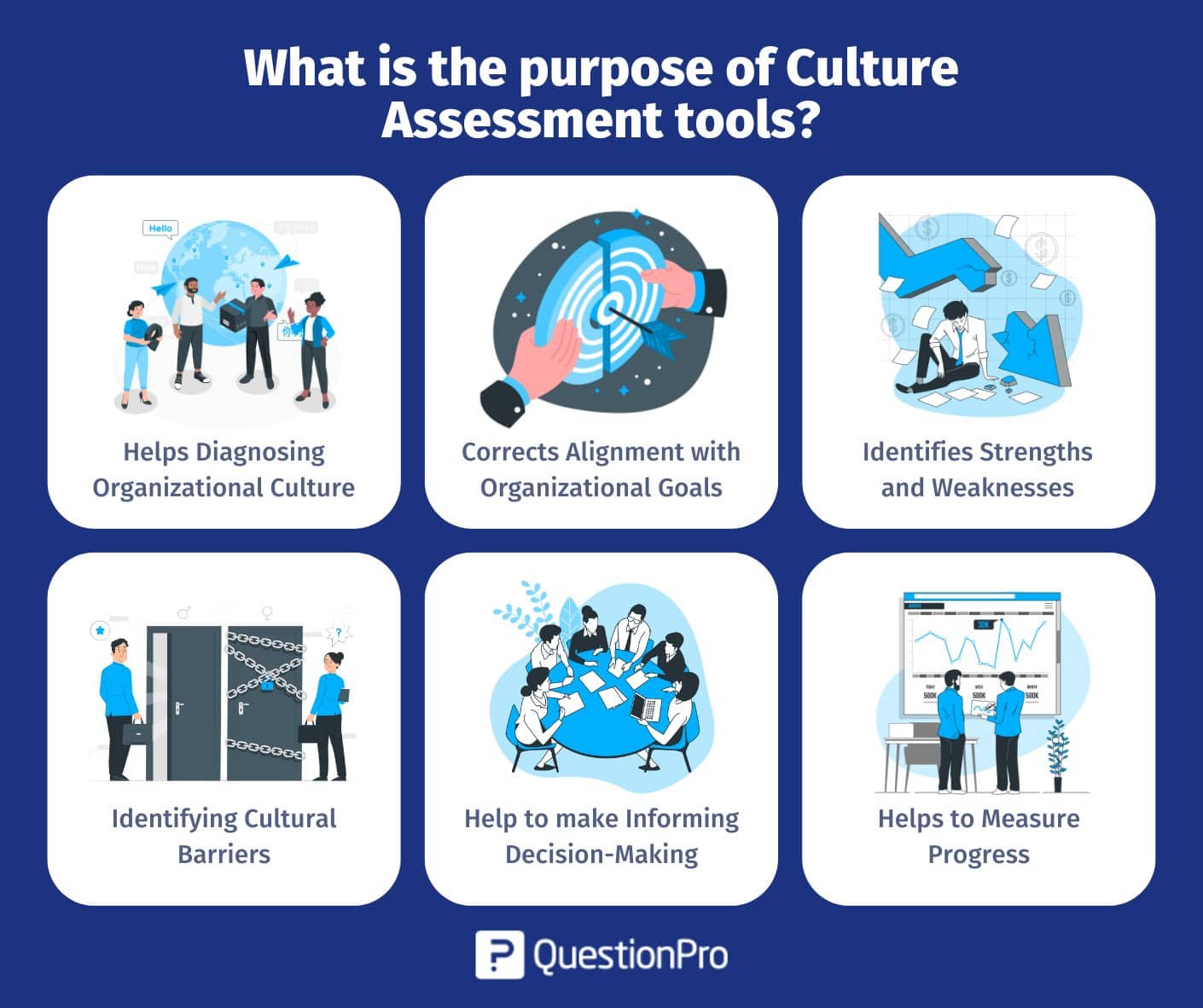
1. Helps Diagnosing Organizational Culture
Culture assessment tools serve to diagnose an organization’s culture deeply, uncovering shared values, beliefs, behaviors, and practices among employees. This comprehensive understanding sheds light on prevailing norms and dynamics within the organization.
2. Corrects Alignment with Organizational Goals
These tools evaluate how well the current culture aligns with the organization’s:
- Mission.
- Vision.
- Strategic objectives.
Leaders can assess whether the culture actively supports or impedes the achievement of these critical goals.
3. Identifies Strengths and Weaknesses
By examining communication patterns, leadership styles, and collaboration norms, culture assessment tools pinpoint organizational strengths to leverage and weaknesses to address. This assessment guides strategic initiatives for improvement.
4. Identifying Cultural Barriers
Culture assessment tools reveal barriers within the organizational culture that hinder effectiveness, innovation, or growth. These barriers may include resistance to change, communication silos, or issues related to diversity and inclusion.
5. Help to make Informing Decision-Making
Insights gleaned from culture assessments provide a data-driven foundation for decision-making in:
- Organizational development.
- Change management.
- Talent management.
- Leadership strategies.
They enable targeted interventions to enhance organizational effectiveness.
6. Helps to Measure Progress
Acting as benchmarks, culture assessment tools track changes in organizational culture over time. Regular assessments enable organizations to measure progress, evaluate the impact of interventions, and adjust strategies accordingly to foster continuous improvement.
This detailed exploration underscores how culture assessment tools serve as pivotal instruments for organizations striving to understand, align, strengthen, and evolve their organizational culture strategically.
Finding the Right Culture Assessment Tool
The first step is to assess your culture, and we’re not going to hide our bias: we have developed an assessment included in our Workplace Genome ® Platform, and we think it’s really powerful.
That being said, we’re not so blind that we don’t realize that other assessments may work better for you at your particular point of cultural evolution.
Culture change is complex, and each organization is unique, so don’t expect to find any valid science that “proves” one assessment is better than the others. We think there are a lot of good assessments out there that will provide value to you as you go down the road of culture change.
There are better than outright bad ones, but unfortunately, it will be hard to tell the difference once you use them. (And then it’s too late!) So, research to find one that will be best for you. Here are some aspects we think should be present in an assessment:
01. Backed by theory
The theory may be too strong a word. A hearty set of principles will probably do. All assessments point you in a direction. They’ve given thought to what matters and why. Ensure you are comfortable with the underlying thinking behind that direction, or you’ll be disappointed with the assessment.
For example, as we’ve made clear in previous chapters, our Workplace Genome assessment measures along the eight Culture Makers of Agility, Collaboration, Growth, Inclusion, Innovation, Solutions, Technologies, and Transparency.
Those come from the theory and research that went into our books, Humanize and When Millennials Take Over (as well as decades of experience). You’ll have to make the call about whether or not that competing values framework (or any assessment’s underlying framework) will work for your organization. But we’re wary of assessments that lack a grounding in principles.
We’re equally wary of assessments that compare your culture to a control group of “outstanding” organizations. Just because it worked for them doesn’t mean it will work for you.
02. Balanced between descriptive and prescriptive
The assessment can point you in a direction, but it shouldn’t tell you precisely what to do. Look for a balance in how the 360 leadership assessment describes your culture versus telling you how it thinks you should be.
You need both sides to develop strong insights. The actual data from our Workplace Genome assessment focuses very intently on “what is,” showing you where your culture falls along the continuum of a traditionalist to futurist along all eight Markers.
Then, we provide you with resources and support to align your culture with what drives success, and that’s where you get into the “what should be” part.
03. Balanced between quantitative and qualitative data
Both types of data are valid, and each informs the other. In addition, different people tend to value different kinds of data, so it helps to have both as part of the assessment.
04. It leaves you in control, not the consultant
In some contexts, you want consultants to reach deep into their expertise and tell you exactly what to do. Culture change is not one of them. You want the assessment to shine a light for you, help you see things you hadn’t seen before, and help you get clear on what’s important and what drives success.
And then you need to step up and plan the action to make it happen. Make sure it leaves you that control culture.
05. Fits with your culture (and cultural aspirations)
This may sound like putting the cart before the horse, but if you’re getting serious about changing your culture, you already have a basic sense of the current and future state. Make sure the assessment is compatible.
For example, an assessment that relies exclusively on qualitative storytelling for data may need more credibility in a science- or engineering-based company. The goal of the evaluation is to facilitate action afterward, so the assessment should be selected with that in mind.
Why do organizations use a Culture Assessment Tool?
Organizations use Culture Assessment Tools for several reasons:
- Understanding Culture: These tools help organizations understand their existing culture – the shared beliefs, values, behaviors, and attitudes that characterize the organization.
- Diagnosing Issues: Culture Assessment Tools can identify areas where the current culture may not align with organizational goals or may be causing issues such as low morale, high turnover, or lack of innovation.
- Change Management: If an organization is changing, such as through a merger, restructuring, or shift in strategy, these tools can assess the current culture and help leaders understand what needs to change and how to manage that change effectively.
- Employee Engagement: Assessing culture can provide insights into employee satisfaction, employee engagement, and well-being, helping organizations create a more positive and supportive work environment.
- Recruitment and Retention: A solid organizational positive culture can attract top talent and retain good-fit employees, leading to higher performance and lower turnover. Cultural assessment tools can help identify and promote the aspects of culture most attractive to employees.
- Leadership Development: Culture Assessment Tools can also be used to assess leadership effectiveness and identify areas for leadership development or training.
- Strategic Alignment: Assessing culture can ensure that the organization’s culture is aligned with its strategic objectives, values, and mission, enabling better decision-making and execution of strategic initiatives.
Planning and Implementation of Culture Assessment Tools
Once you have the assessment results, you’ll be ready to plan and implement some changes. The assessment should have helped you clarify what is truly valued (based on what drives success), and hopefully, you now also have some clarity about the current and desired state of your culture.
Planning and implementing an organizational culture assessment instrument involves a strategic and systematic approach to gaining insights into organizational culture and driving meaningful change.
Don’t worry if those two pictures are not 100 percent complete. You can fill in the gaps as you go along. But you should have enough clarity to start the culture work, which will include these areas:
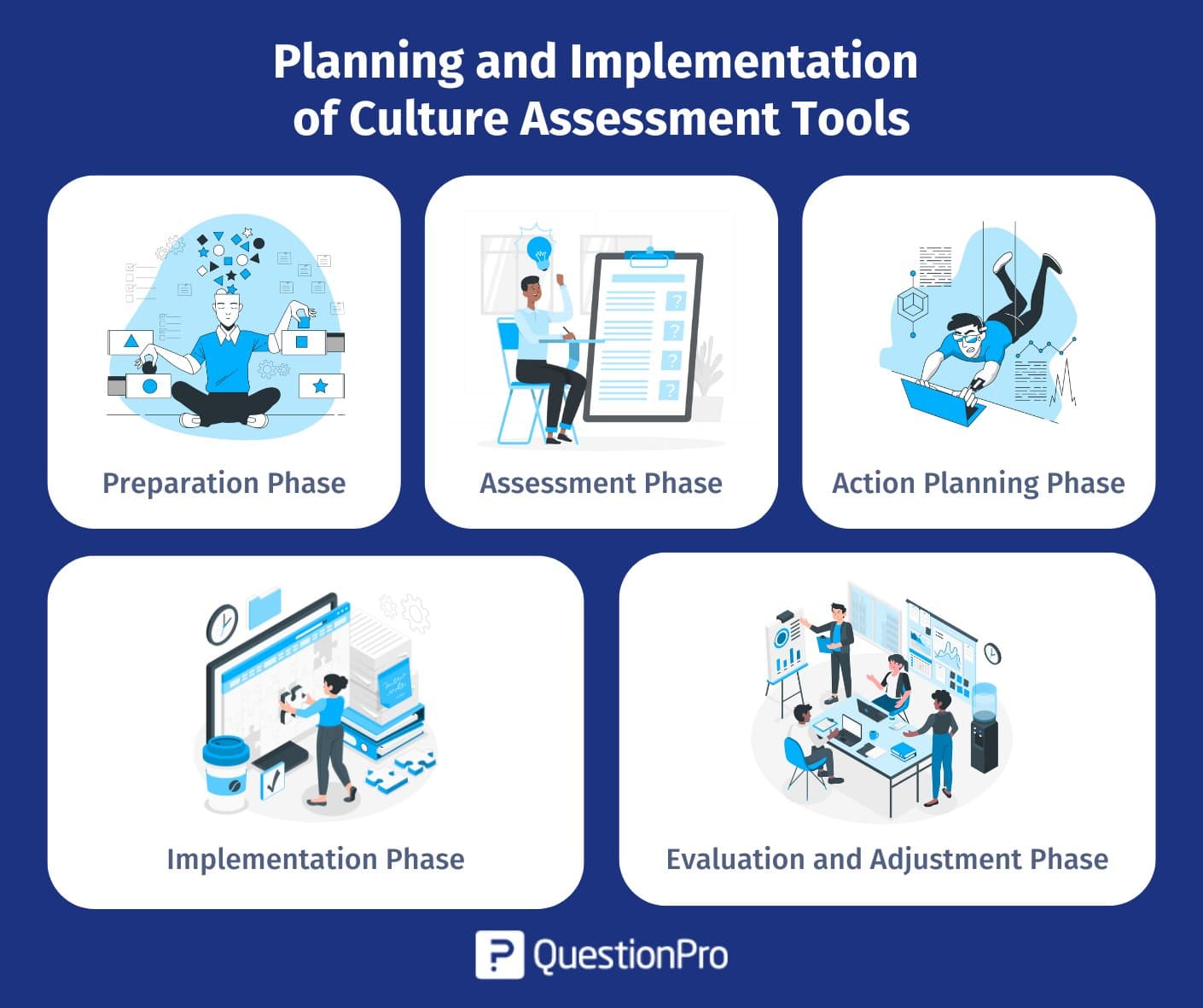
1. Preparation Phase
Once you have the assessment results, you’ll be ready to plan and implement some changes, such as
- Define Objectives: Clearly articulate the objectives of conducting a culture assessment survey. Determine what aspects of the culture you aim to understand or improve.
- Stakeholder Engagement: Involve key stakeholders, including senior leadership, HR professionals, and employees from diverse levels and departments, in the planning process. Ensure buy-in and support for the assessment initiative.
- Select or Develop Tool: Choose or develop a Culture Assessment Tool that aligns with the organization’s goals, culture, and specific focus areas. Consider using surveys, interviews, focus groups, or observation techniques.
2. Assessment Phase
The assessment should have helped you clarify what is truly valued (based on what drives success), and hopefully, you now also have some clarity about the current and desired state of your culture, like
- Communication: Communicate the purpose and importance of the culture assessment to all employees. Ensure transparency and encourage participation to gather comprehensive data.
- Data Collection: Administer the chosen assessment tool to gather data on various aspects of assessing workplace culture, including values, beliefs, behaviors, and practices. Ensure anonymity and confidentiality to encourage honest responses.
- Analyze Results: Thoroughly analyze the assessment results to identify patterns, trends, and areas for improvement. Consider quantitative and qualitative data to gain a holistic understanding of the culture.
3. Action Planning Phase
This phase requires translating assessment findings into actionable plans, identifying key areas for improvement, and setting clear objectives for cultural development, like
- Interpret Findings: Interpret the assessment findings to understand the current state of the culture, including its strengths, weaknesses, and areas for development.
- Define Goals: Based on the assessment results, define clear and actionable goals for improving cultural assessment. Prioritize areas that align with organizational priorities and strategic objectives.
- Develop Action Plan: Create a detailed action plan outlining specific initiatives, strategies, and timelines for addressing identified areas for improvement. Assign responsibilities and allocate resources accordingly.
4. Implementation Phase
You can fill in the gaps as you go along in this stage
- Engage Leadership: Secure leadership commitment and support for the cultural change initiatives. Leaders should model desired behaviors, communicate openly, and champion the change effort.
- Employee Involvement: Involve employees at all levels in the implementation process. Encourage participation, feedback, and collaboration to foster ownership and commitment to the change.
- Training and Development: Provide training and development opportunities to equip employees with the skills, knowledge, and mindset required to embrace and sustain the desired culture.
- Monitor Progress: Continuously monitor and evaluate the progress of culture change initiatives. Track key performance indicators, gather employee feedback, and make necessary adjustments to ensure effectiveness.
5. Evaluation and Adjustment Phase
But you should have enough clarity to start the culture work, which will include these areas:
- Assess Impact: Evaluate the impact of culture change initiatives on organizational performance, employee engagement, and other relevant metrics. Determine whether the desired cultural shifts are occurring and whether goals are being met.
- Continuous Improvement: Use evaluation findings to inform ongoing refinement and adjustment of cultural change strategies. Embrace a constant improvement, learning, and adaptation culture to sustain positive change.
What are the benefits of using a Culture Assessment tool?
Using a Culture Assessment Tool offers several benefits to organizations:
- Insight into Organizational Culture: It provides a deeper understanding of the organization’s prevailing culture, including its values, beliefs, norms, and behaviors.
- Identification of Strengths and Weaknesses: Culture assessment tools help identify the strengths that can be leveraged to enhance performance and the weaknesses that may need to be addressed to improve organizational effectiveness.
- Alignment with Organizational Goals: By assessing the alignment between culture and organizational goals, leaders can ensure that the culture supports achieving strategic objectives.
- Informed Decision-Making: The insights from culture assessments inform decision-making processes related to organizational development, talent management, leadership strategies, and change initiatives.
- Enhanced Employee Engagement and Satisfaction: Understanding the culture allows organizations to identify factors influencing employee engagement, satisfaction, and retention, leading to initiatives that improve the overall employee experience.
- Promotion of Diversity and Inclusion: Culture assessment tools help identify opportunities to foster a more inclusive environment where diversity is valued, leading to increased innovation, creativity, and collaboration.
- Identification of Cultural Barriers: They uncover cultural barriers that may hinder organizational effectiveness, innovation, collaboration, or growth, enabling organizations to address these challenges proactively.
- Benchmarking and Progress Measurement: Culture assessment tools serve as benchmarks to measure changes in positive company culture over time, allowing organizations to track progress, evaluate the impact of interventions, and adjust strategies accordingly.
- Enhanced Leadership Development: They provide valuable insights into leadership behaviors and practices aligned with the organizational culture, informing leadership development initiatives and succession planning.
- Creation of a Positive Work Environment: Ultimately, culture assessment tools help organizations create a positive work environment where employees feel valued, engaged, and motivated to contribute to the organization’s success.
How does QuestionPro Workforce Help in Doing Cultural Assessment?
QuestionPro Workforce is a comprehensive platform that offers various tools and features specifically designed to assist organizations in conducting cultural assessments effectively. Here’s how QuestionPro Workforce can help in doing cultural assessment:
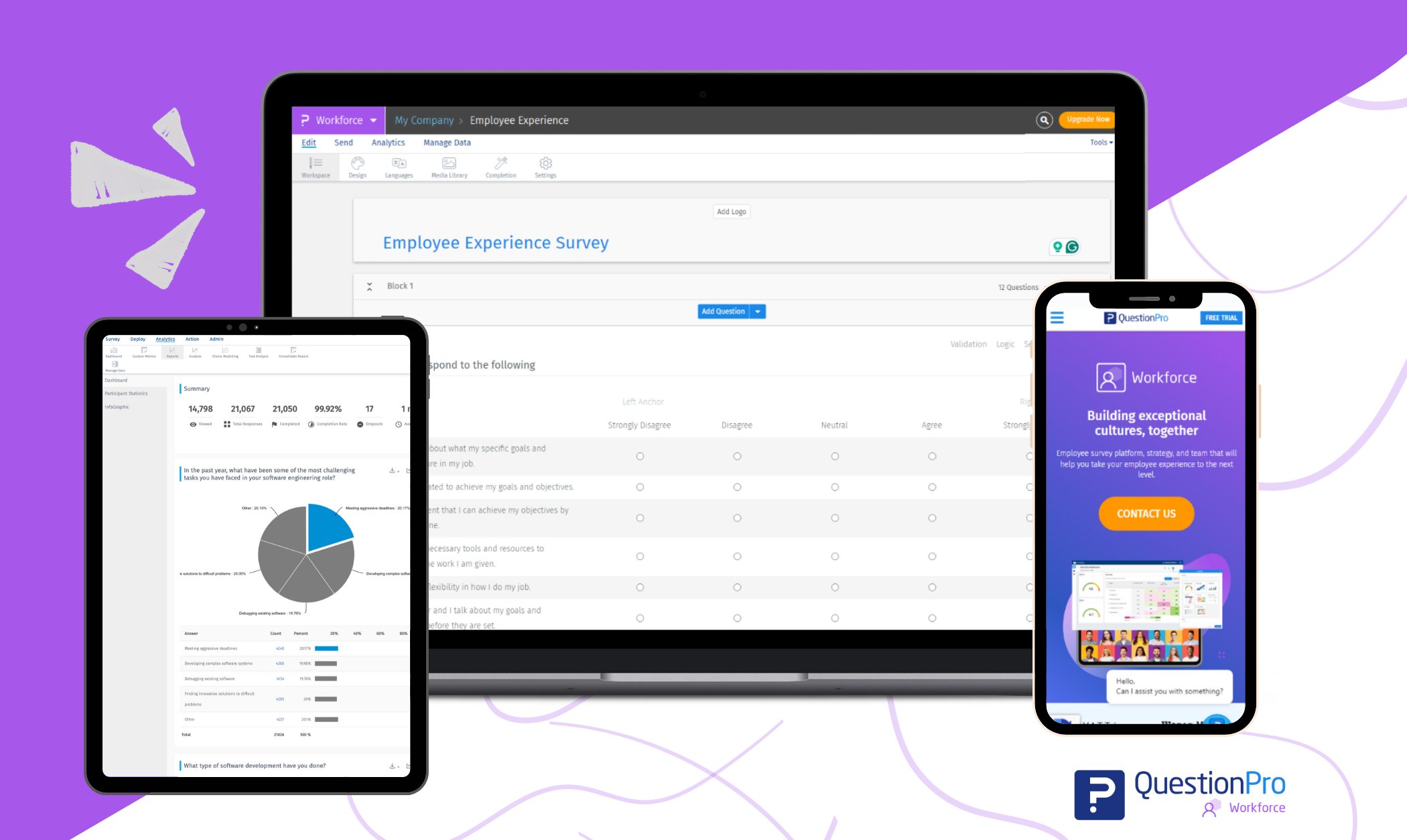
01. Customizable Surveys
QuestionPro Workforce provides various customizable survey templates tailored for cultural assessments. These surveys can be adapted to gather feedback on different aspects of organizational culture, such as
- Values,
- Beliefs,
- Behaviors and
- Practices.
02. Multi-channel Data Collection
The platform supports multi-channel data collection, allowing organizations to reach employees through various channels, including
- Email,
- Web,
- Mobile and
- Social media.
This ensures higher response rates and greater participation in the cultural assessment process.
03. Anonymous Feedback
QuestionPro Workforce enables organizations to collect anonymous feedback, creating a safe and open environment for employees to share their honest opinions and perceptions about the organizational culture without fear of reprisal.
04. Advanced Analytics
The platform offers advanced analytics and reporting features, allowing organizations to analyze real-time cultural assessment data. Users can generate customizable reports, charts, and graphs to visualize trends, identify patterns, and gain actionable insights into the current state of the culture.
05. Benchmarking and Comparison
QuestionPro Workforce allows organizations to benchmark their cultural assessment results against industry standards or previous assessments. This enables them to identify areas of strength and improvement relative to their peers.
06. Action Planning and Collaboration
The platform facilitates action planning and collaboration by enabling users to create action items, assign tasks, and track progress toward cultural improvement goals. This ensures that insights from the cultural assessment are translated into tangible actions and initiatives.
07. Continuous Monitoring and Feedback
QuestionPro Workforce supports continuous monitoring and feedback collection, allowing organizations to track cultural changes over time and gather ongoing employee feedback. This enables them to adapt strategies and interventions based on evolving needs and challenges.
08. Expert Support and Guidance
The platform provides expert support and guidance throughout the cultural assessment, including
- Survey design,
- Data analysis and
- Action planning.
Users can access a dedicated team of consultants and specialists who can offer best practices and recommendations for maximizing the assessment’s effectiveness.
Conclusion
Understanding and navigating organizational culture is a dynamic process requiring deliberate effort and strategic insights. Culture assessment tools are invaluable allies in this endeavor, offering clarity, direction, and actionable insights.
By effectively leveraging these tools, organizations can understand their culture and drive meaningful change, fostering a culture of excellence, innovation, and growth.
QuestionPro Workforce offers a comprehensive suite of tools and features that can help organizations conduct cultural assessments efficiently, gather meaningful insights, and drive positive cultural change within their organizations.
Are you interested in knowing more?
Awesome! We love to talk about culture.
Frequently Asked Questions (FAQs)
A: A Culture Assessment Tool is an instrument used to evaluate and understand an organization’s culture by gathering data on values, behaviors, and practices.
A: Organizations use Culture Assessment Tools to diagnose their current culture, identify strengths and weaknesses, and align their culture with strategic goals.
A: These tools provide insights that guide decision-making and help manage and track cultural change effectively.
A: Look for tools that are theory-based, balance qualitative and quantitative data, and provide actionable insights without overly prescriptive recommendations.
A: QuestionPro Workforce offers customizable surveys, advanced analytics, and expert support to help organizations assess and enhance their culture.




